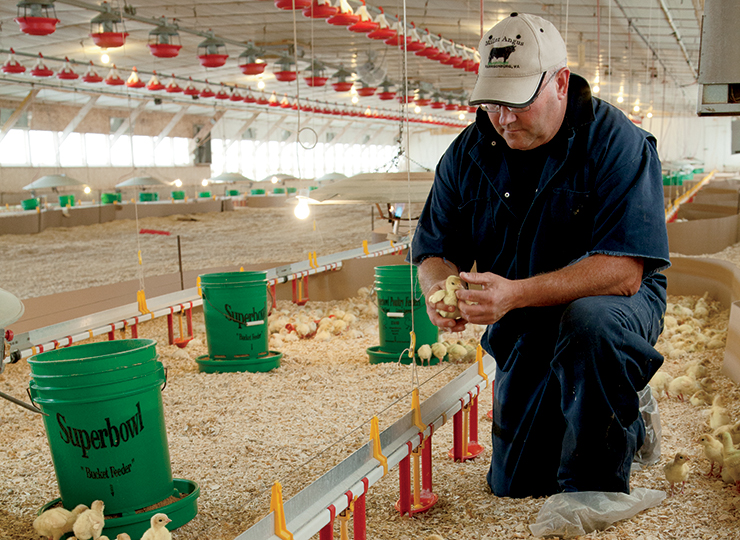Home > Virginia > Virginia Crops & Livestock > Poultry Progress: Virginia Regarded as Home of Modern Production
Poultry Progress: Virginia Regarded as Home of Modern Production
In partnership with: Virginia Department of Agriculture and Consumer Services

Virginia is home to a thriving poultry industry that has an economic impact of more than $8 billion, according to a study by the U.S. Poultry and Egg Association. With its rich history in poultry, it’s no surprise that six processing companies and 1,100 farm families have flocked to the state.
Broilers, turkeys and eggs all rank among the top 10 agricultural commodities for Virginia, and the state ranks ninth nationally for broilers and fifth in turkey production. What’s more, all this success in the poultry industry means more jobs for Virginians, directly providing more than 13,480 jobs and indirectly contributing to employment for 41,710 people.
“The biggest reason Virginia is such a strong poultry-producing state is our positive business climate, as we have elected leaders who understand the economic importance of agriculture,” says Hobey Bauhan, president of the Virginia Poultry Federation.
Home to Modern Poultry
Poultry processing and production have a storied history in the region, with many contending that the modern U.S. poultry industry was born in the Shenandoah Valley during the early 1900s. Bauhan explains that a man from Harrisonburg, Charles W. Wampler, Sr., is considered the father of the modern poultry industry for his experiments using large-scale hatcheries and confinement systems.
“That led to the modern poultry industry where poultry are raised in climate-controlled barns designed to maximize health and welfare by providing a nutritious diet, fresh water, good bedding material and a good ventilation system,” Bauhan says.
Because of these technological advances, today’s farmers are able to use less than two pounds of feed to grow one pound of chicken, compared to five pounds of feed per pound of chicken in the past. It once took 14 weeks to grow three pounds of chicken. Now, farmers can grow a four-and-a-half pound chicken in less than six weeks.
“These increases are all a result of scientific research, improved genetics, improvements in diet and advances in husbandry,” says Bauhan.

Vertical Integration
Innovation and advances to improve yields are necessary to produce enough poultry products to feed the world. According to the United Nations, the world will need to double food production by the year 2050 to feed its growing population. Virginia’s poultry producers can help meet that challenge and grow into the future by developing access to the growing export market, Bauhan says.
In addition to implementing progressive improvements, Bauhan also credits Virginia’s expanding poultry industry to the development of vertical integration.
Vertical integration is where a poultry processing company owns the poultry, the hatchery, the feed mill, the fleet of trucks and the processing plant. The processor employs service staff, veterinarians, nutritionists and others to work with the contract growers, who are independent family farmers.
One farmer who enjoys the benefits of such an arrangement is Craig Miller, owner and operator of a turkey and beef operation outside Harrisonburg.
“Since we are integrated, it takes quite a bit of the risk out of it for me,” Miller says. “It’s an industry where we pretty much know from year to year close to what we’re going to make. There is no other agricultural commodity in the state that offers that protection.”
Miller raises hens, which he receives and begins to care for on the day they hatch. He keeps the birds for 88 to 90 days until they are about 16 pounds. Miller, a former teacher, has been farming full time since 1988, and has witnessed many innovations in poultry production.
“The biggest change in the past 10 years has been computers,” Miller says. “The computer totally controls the environment that they’re in, including the temperature and the ventilation.”
Having the computer to carefully monitor the environment for optimum conditions takes much of the guesswork out of raising the birds and allows Miller to focus on the turkeys themselves.
“I really do enjoy raising turkeys, and it’s nice to be able to go in when you make your checks and be able to just observe what the turkeys are actually doing and seeing how they feel,” Miller says.

Environmental Concern
In addition to caring for his birds, Miller is also focused on the environment, implementing sound practices on his farm, including a system to capture 30 percent of the rainwater coming off of the poultry houses to halt erosion.
“I’ve always tried to be really progressive as far as environmental issues,” Miller says. “I want to make sure our farm looks good and I’m doing the right things for the environment.”
Miller sees the future as bright for Virginia’s poultry farmers, as long as they continue to hatch new ideas to improve production.
“I love it, and I’m going to keep doing it as long as I can,” Miller says. “I’m a real optimist because I love agriculture.”



